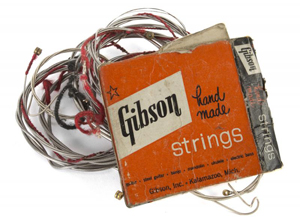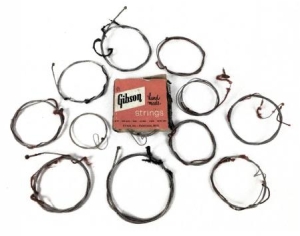Pete’s Gear: Pete’s Guitar strings
Select an era:
1964–1967 – Tape-wound Rickenbacker strings
For Rickenbacker guitars, Pete likely used tape-wound Rickenbacker guitar strings.
Likely configuration for 12-strings:
- .010/.010
- .013/.013
- .020/.010
- .026/.013
- .034/.020
- .042/.026
Likely configuration for 6-strings:
- .010
- .013
- .017
- .026
- .034
- .042
1967 – Fender strings
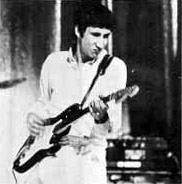
1967
Documented for 1967 is Pete’s use of Fender strings. In 1967 and 1968 on Fender Stratocasters, he likely used Fender pure nickel wrap #1500 Spanish Guitar [Smooth Round Wound]. These sets were standard issue on new Fender guitars 1966–1969.
- .012
- .016
- .016p (substituted for .026w)
- .034
- .044
- .052
Pete likely substituted the .016 (plain) for the set’s .026 (wound) for the G string, as was a common for British guitarists in the early to mid ’60s, a practice Pete would continue into the ’70s with his Gibson guitars.
Selected quotes
All quotes and references are copyright their original owners and are included for reference only.
From Guitar Player, October 1967
Excerpts from an interview with John Entwistle and Pete Townshend conducted June 18, 1967, in San Francisco, just prior to the Who’s appearance at the Monterey Pop Festival.
- GP: Picks and strings?
Entwhistle [sic.]: We both use Herco heavy-gauge nylon picks. And I use Roto-Sound heavy-gauge wirewound strings; they’re only available in England.
Townsend [sic.]: I use regular Fender Strings.
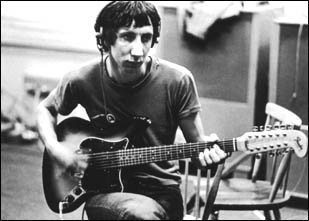
Ca. 1969, in the studio with Fender Electric XII.
It is also possible that, for the recording of Tommy, when using the Fender Electric XII 12-string guitar (as heard on Sparks, Underture, etc.), that he used Fender’s electric 12-string nickel-wound set: #1450 12-String Guitar:
- .010/.010
- .013/.013
- .022w/.010
- .026w/.013
- .034/.016
- .044/.022w
Fender Catalogues
Below are scans of Fender catalogues circa 1966 and 1969, courtesy Hal Rollins <hal526@mindspring.com> and Steve Barr <vintgebass@aol.com>.

Click to view larger version (194k). 1966 Fender strings catalogue, Page 1. Courtesy Hal Rollins and Steve Barr.

Click to view larger version (252k). 1966 Fender strings catalogue, page 2. Courtesy Hal Rollins and Steve Barr.

Click to view larger version (349k). 1969 Fender strings catalogue. Courtesy Hal Rollins and Steve Barr.
1968–1982 – Gibson 340 Sonomatic strings
Gibson 340 Sonomatic .012 strings (with a .016 for both B and G strings):
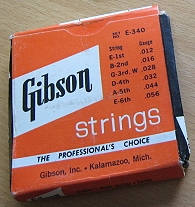
A set of Gibson 340 strings of Pete’s from early ’70s, courtesy rockstarsguitars.com.
- .012
- .016
- .016
- .032
- .044
- .056
Beginning 1976 or earlier, the strings are changed every set on the primary instrument by Alan Rogan. An .018 is used for the G string:
- .012
- .016
- .018
- .032
- .044
- .056
Selected quotes from Pete Townshend about Gibson guitar strings
All quotes and references are copyright their original owners and are included for reference only.
From May/June 1972 Guitar Player
- GP: In your string setup, I imagine you would select a heavier gauge on the bottom and a lighter on the top because of your combination lead and rhythm playing?
PT: No, that’s the setup you get when you buy a regular gauge Sonomatic set, but I use a .056, .044, .032, .028, another .028 and a .022 [Whotabs:this is a typo — it was actually .056, .044, .032, .016, .016, .012.] for the top. It’s a heavy set and it’s heavier at the top, relatively, than it is at the bottom.
- GP: You like the pull more than the slinky feel?
PT: Yeah, if I’m going to hit a note or bend it, I really want to have to struggle for it, because I’m so physically wound up on the stage. If I wanted to, I could pull the string up and break it with my hand. it’s really weird, when I’m in the dressing room playing, I can hardly stretch the strings, and then when I go on stage I get a buzz and the strings feel slinky, they really feel slinky. The first guy that I met — my idol in England, was a guy named Mickey Green, who used to play with Johnny Kitten [sic; Kidd] and the Pirates, and he was the first big note-bender, particularly on the G. And you’d freak over Jimmy Burton and you’d freak over Mickey Green and you wondered how they got that sound. Went to see a guy about it and he said it was the thin G, he uses like two 2nds instead of a G, right? So I got my guitar and I really got into it. I got to see Mickey play, and I went back stage to see him and I asked him if I could play his guitar and he said, “Sure, man.” I picked it up, and he’s got strings like bloody piano strings, they’re huge! And the G isn’t plain, it’s wound, and he used to stretch it practically to the A string and beyond. Big hands, and he would pull it down and tuck it under as well. That’s what really buzzed me out, using the heavy strings, ’cause a lot of younger guitarists tend to get the light strings and they get into quickbending riffs, and all those Jeff Beck trips. But it’s like the fretboard and the pickup doing it and you’re just piddling about. Freddie King, who is my man at the moment, does a bend and he’s pulling it a good inch to get that sound, he works for it. If you’re going to bit a note, you’ve got to work for it. Leslie West, who is another amazing guitarist, he hits them. He gave me an old Les Paul Junior once, like the kind he uses and it was strung like the way he uses it, and his strings are not particularly very light. They’re a bit lighter than what I use, but not much.
- GP: Why the two .028’s for both the G and B strings?
PT: I like them because if I stretch them with those two fingers, if I hit say an A and stretch the G and B up like that, when I get to a certain point they go from a major to the major fifth, in tune. And if the gauges are wrong they stretch differently, and I have to separate the fingers to get them in tune, maybe I have to push the G a bit more than the B or something.
From April 1980 issue of Sound International article, courtesy Joe G’s site.
[Referring to the SG Special:] They just brought out a new model and this was in 1968 and it had a slightly larger wound pickup and it really suited my amplifiers. I started to use those and they were a bit weak, which was the only problem; I could actually break them with my bare hands. But that’s when I started to develop that technique because you didn’t need a tremolo arm. You could do it by just shaking the guitar. I got into this thing also of temper tuning the guitar with the second string flat, and pulling back slightly on the guitar all the time to bring it into pitch. So using that on some of the higher chords where you wanted that second string to voice a bit flat, you could relax the guitar and it would come out a bit flatter. No, sorry, I meant the G string. When you’re using a lighter G — I’ve never used light gauge strings. I’ve always used heavy strings — you can do that. The top string (high E) is an .012 downwards and I use two Bs instead of a B and a G string. I got that from Jimmy Burton, that’s what he used to use. I can’t stand light strings, you don’t have to struggle for it. Mickie Green, who is a guy who used to play with Johnny Kidd and The Pirates, was a great experimenter with the Jimmy Burton technique. He used to have this great lyrical string bending thing going on and I went up to him one day and said, ‘What kind of strings do you use?’ and he said, ‘What?’ And I said, ‘Do you have a plain third?’ And he said, ‘A plain what?’ He just had big hands; he used to bend the third, a wound third, right up and over the back of the neck. That was an affirmation to me that if you wanted to do it you fought for it. I hate that guitar sound where people sound like they can bend the string just by kind of thinking about it.
I [now; circa 1980] use Gibson Sonomatic strings, medium gauge. It’s and .012 on the top, .016 for the B, .018 for the G. I don’t use two Bs anymore. I’ve started to make the G a bit heavier.
Auction Profile
Pete Townshend Tour Used Guitar Strings
Julien’s Auctions “Music Icons 2018” on 19 May 2018
A group of 12 guitar strings, one in original Gibson packaging, used by Pete Townshend while performing with The Who on The Who Tour 1971 in the United Kingdom. Accompanied by a copy of a letter of authenticity from Bill Holdsworth, a roadie on the tour, and a certificate of authenticity from Tracks Ltd.
Packaging, 3 1/2 by 3 1/2 inches
Estimate: $800–$1,200
Realised: U.S.$875
1989–present – Ernie Ball strings
Ernie Ball nickel-wound strings feature nickel-plated steel wire wrapped around tin-plated hex-shaped steel core wire.
1989
Ernie Ball Light Gauge Nickel-Wound .011–.052 strings:
- .011
- .015
- .018p replacing .022w
- .030
- .042
- .052
1996–1998
Ernie Ball nickel or D’Addario strings:
- .011
- .015
- .018
- .032
- .042
- .052
1999–2006
Ernie Ball .011–.052 nickel strings:
- .011
- .015
- .018
- .032
- .042
- .052
2005 (possibly)
According to Ernie Ball Artist Relations, Pete is using Ernie Ball Skinny Top/Heavy Bottom #2215:
- .010
- .013
- .017
- .030
- .042
- .052
2014–16
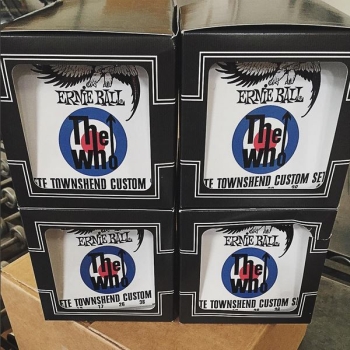
A case of Ernie Ball PT Custom strings (.010, .013, .017, .026, .036, .048).
Ernie Ball RPS Slinky Nickel-Wound #2240 (with .048 replacing .046 E string):
- .010
- .013
- .017
- .026
- .036
- .048
Stage acoustics
1989
Ernie Ball bronze medium .013–.056 strings.
1996–1997
Reported as D’Addario .011 (likely .013)–.056 strings.
2000–present
Likely .013–.056 or .012–.054 Ernie Ball strings.
In 2005, according to Ernie Ball Artist Relations, Pete is using Ernie Ball Regular Slinky #2146 Acoustic Phosphor Bronze strings:
- .012
- .016
- .024w
- .032
- .044
- .054
As of 2005, Alan Rogan reports Pete is using D’Addario EXP19 (.012–.056; Light Top/Medium Bottom) phosphor bronze strings on his J200 acoustics. (Thanks to Kenny Freed)
- .012
- .016
- .025w
- .035
- .045
- .056
Alan Rogan discusses Pete’s use of D’Addario strings on his Gibson J-200 stage acoustics.
Resources and Information
Contributors
Thanks to those who have made this page possible:
- Craig Glasheen (redeemedweb.tripod.com), for reporting on the latest Ernie Ball strings.
- Kenny Freed, for reporting the D’Addario strings from 2005.
Manufacturer’s Sites
- Rickenbacker: rickenbacker.com/cart.asp?category=Strings
- Pyramid Strings: pyramidstrings.com
- Fender: fender.com
- Gibson: gibson.com
- Ernie Ball: ernieball.com
- D’Addario: daddario.com
